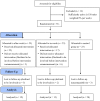Changes in Physical Activity Behaviour and Health Risk Factors Following a Randomised Controlled Pilot Workplace Exercise Intervention
- PMID: 29546212
- PMCID: PMC5689804
- DOI: 10.3934/publichealth.2017.2.189
Changes in Physical Activity Behaviour and Health Risk Factors Following a Randomised Controlled Pilot Workplace Exercise Intervention
Abstract
Background: Declining physical activity (PA) and associated health risk factors are well established. Workplace strategies to increase PA may be beneficial to ameliorate extensive sedentary behavior. This study assessed the effectiveness of two PA interventions in workplace settings.
Methods: Interventions were conducted over 40 days targeting insufficiently active (<150 min/wk PA) and/or obese (BMI ≥ 30 kg/m2) adults; participants were randomly allocated to instructor-led exercise sessions either after-work (n = 25) or in-work (n = 23) with a 60 minPA/day common goal, or a wait-listed control group (n = 23). The programme commenced with low-moderate physical activities and progressed to high intensity game style activities by week six. Adherence and compliance were determined using both objective measures of daily PA time from HR monitors and self-report responses to PA questionnaires. Cardiovascular and metabolic risk factors were measured pre- and post-intervention. Changes across the study were analysed using Chi square and repeat-measures ANOVA.
Results: Adherence rates (completed pre and post-testing) were not different between groups (76.0 vs 65.2%). Compliance for the instructor-led sessions was higher for the after-work group (70.4% vs 26.4%, respectively). Increased total PA and aerobic fitness, and decreased weight in both intervention groups were found relative to controls. The after-work group undertook more vigorous PA, and had greater weight loss and fasting blood glucose improvement, relative to in-work participants and controls.
Conclusions: These workplace interventions resulted in rapid and dramatic increases in PA behaviour and important health benefits. Short, in-work PA sessions were less efficacious than longer after-work sessions.
Keywords: health outcomes; physical activity; workplace interventions.
Figures


Similar articles
-
The effectiveness of multi-component interventions targeting physical activity or sedentary behaviour amongst office workers: a three-arm cluster randomised controlled trial.BMC Public Health. 2020 Sep 1;20(1):1329. doi: 10.1186/s12889-020-09433-7. BMC Public Health. 2020. PMID: 32873260 Free PMC article. Clinical Trial.
-
Adherence, Compliance, and Health Risk Factor Changes following Short-Term Physical Activity Interventions.Biomed Res Int. 2015;2015:929782. doi: 10.1155/2015/929782. Epub 2015 Aug 25. Biomed Res Int. 2015. PMID: 26380308 Free PMC article. Clinical Trial.
-
Effects of a peer-led Walking In ScHools intervention (the WISH study) on physical activity levels of adolescent girls: a cluster randomised pilot study.Trials. 2018 Jan 11;19(1):31. doi: 10.1186/s13063-017-2415-4. Trials. 2018. PMID: 29325578 Free PMC article. Clinical Trial.
-
Supporting active ageing before retirement: a systematic review and meta-analysis of workplace physical activity interventions targeting older employees.BMJ Open. 2021 Jun 30;11(6):e045818. doi: 10.1136/bmjopen-2020-045818. BMJ Open. 2021. PMID: 34193489 Free PMC article.
-
Workplace interventions for increasing standing or walking for decreasing musculoskeletal symptoms in sedentary workers.Cochrane Database Syst Rev. 2019 Nov 17;2019(11):CD012487. doi: 10.1002/14651858.CD012487.pub2. Cochrane Database Syst Rev. 2019. PMID: 31742666 Free PMC article.
Cited by
-
The MedXFit-study - CrossFit as a workplace health intervention: a one-year, prospective, controlled, longitudinal, intervention study.Front Public Health. 2024 Feb 21;12:1304721. doi: 10.3389/fpubh.2024.1304721. eCollection 2024. Front Public Health. 2024. PMID: 38450146 Free PMC article. Clinical Trial.
-
Dropout and compliance to physical exercise in menopausal osteopenic women: the European "happy bones" project.Front Sports Act Living. 2023 Jun 27;5:1221409. doi: 10.3389/fspor.2023.1221409. eCollection 2023. Front Sports Act Living. 2023. PMID: 37440873 Free PMC article.
-
How do previously inactive individuals restructure their time to 'fit in' morning or evening exercise: a randomized controlled trial.J Behav Med. 2023 Jun;46(3):429-439. doi: 10.1007/s10865-022-00370-x. Epub 2022 Nov 3. J Behav Med. 2023. PMID: 36326985 Free PMC article. Clinical Trial.
-
The efficacy of morning versus evening exercise for weight loss: A randomized controlled trial.Obesity (Silver Spring). 2023 Jan;31(1):83-95. doi: 10.1002/oby.23605. Epub 2022 Dec 10. Obesity (Silver Spring). 2023. PMID: 36502286 Free PMC article. Clinical Trial.
-
CrossFit Motivates a 41-Year-Old Obese Man to Change His Lifestyle and Achieve Long-Term Health Improvements: A Case Report.J Funct Morphol Kinesiol. 2023 May 8;8(2):58. doi: 10.3390/jfmk8020058. J Funct Morphol Kinesiol. 2023. PMID: 37218854 Free PMC article.
References
-
- World Health Organization (WHO) Global Health Risks: Mortality and burden of disease attributable to selected major risks. Geneva: WHO; 2009.
-
- Brown WJ, Miller YD, Miller R. Sitting time and work patterns as indicators of overweight and obesity in Australian adults. Int J Obes Relat Metab Disord. 2003;27:1340–1346. - PubMed
-
- Miller R, Brown WJ. Steps and Sitting in a Working Population. Int J Behav Med. 2004;11:219–224. - PubMed
-
- Department of Health Australia's Physical Activity & Sedentary Guidelines for Adults (18–64 years) 2014. Available from: http://www.health.gov.au/internet/main/publishing.nsf/content/health-pub....
-
- Laddu D, Dow C, Hingle M, et al. A Review of evidence-based strategies to treat obesity in adults. Nutr Clin Prac. 2011;26:512–525. - PubMed
LinkOut - more resources
Full Text Sources
Other Literature Sources
